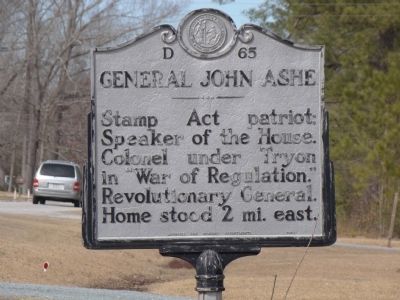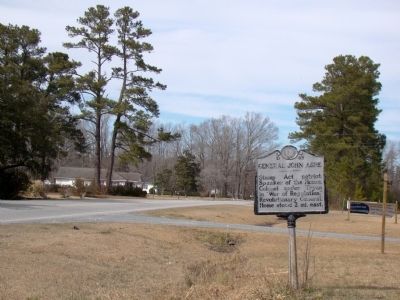Rocky Point in Pender County, North Carolina — The American South (South Atlantic)
General John Ashe
Erected 1962 by Archives and Highway Departments. (Marker Number D-65.)
Topics and series. This historical marker is listed in these topic lists: Patriots & Patriotism • War, US Revolutionary. In addition, it is included in the North Carolina Division of Archives and History series list.
Location. 34° 26.976′ N, 77° 52.974′ W. Marker is in Rocky Point, North Carolina, in Pender County. Marker is on U.S. 117 north of Simpson Lane, on the right when traveling north. Touch for map. Marker is in this post office area: Rocky Point NC 28457, United States of America. Touch for directions.
Other nearby markers. At least 8 other markers are within 7 miles of this marker, measured as the crow flies. James Moore (approx. 0.6 miles away); Maurice Moore (approx. 0.6 miles away); Alexander Lillington (approx. 0.7 miles away); Edward Moseley (approx. 1.7 miles away); Samuel Ashe (approx. 2 miles away); William S. Ashe (approx. 2 miles away); Prisoner Exchange (approx. 5.9 miles away); Early Drawbridge (approx. 6.1 miles away). Touch for a list and map of all markers in Rocky Point.
Also see . . .
1. John Ashe Wikipedia Entry. “John Ashe (c. 1720 – October 24, 1781) was a general officer in the North Carolina militia during the American Revolutionary War. Born to a prominent family in Grovely, Brunswick County, North Carolina around 1720, Ashe enlisted in the North Carolina militia during the French and Indian War. The Harvard-educated Ashe served as Speaker of the colonial assembly from 1762 to 1765 (his father, John Baptista Ashe, had served as speaker in 1726-27). An outspoken opponent of the Stamp Act and eventually a supporter of independence from Great Britain, Ashe served in the North Carolina Provincial Congress and on both the committees of correspondence and safety as hostilities between the colonies and Great Britain began to rise.
“Leading a force of 500 men, Ashe destroyed the British garrison of Fort Johnson (near present day Wilmington, North Carolina) in 1775, becoming a colonel later that year. Raising and equipping a regiment at his own expense, Ashe would later be promoted Brigadier General of militia in April 1776. Dispatched to support Gen. Benjamin Lincoln during the defense of Charleston, South Carolina in 1778, Ashe led a force consisting of 1,200 men to recapture the British-held city of Augusta, Georgia, defended by Col. Archibald Campbell in early 1779. Ashe was at the time serving as one of North Carolina’s state treasurers, so Governor Richard Caswell assumed those duties while Ashe fought.
“While advancing towards Augusta, however, Ashe’s forces were flanked in a surprise attack by Col. James Mark Prevost and routed during the Battle of Briar Creek, with an estimated 150 Americans killed compared to around 16 British casualties, on March 4. Resulting in the effective halt of colonial resistance within Georgia, Ashe was censured by a later court of inquiry for ‘lack of vigilance.’
“Returning to Wilmington, he was captured and held as a prisoner of war following the town’s capture in 1781. Contracting smallpox while imprisoned, Ashe died in Sampson County on October 24 shortly after his parole.
“Governor Samuel Ashe (1725-1813) was his younger brother.”
(Submitted on March 28, 2010.)
2. The Court Martial of General John Ashe. In the voice of Lieutenant Samuel Patton of Captain Fall’s Company. Excerpt: “After the battle there at Briar Creek, we ferried our way across the river best we could with rafts we built and some men even swam across. There was a ferry there that could haul a few men at a time. One officer drowned as he tried to swim across the river.
“After most of the troops was reorganized at Purrysburgh, north of Augusta, where we met up with General Lincoln and camped with his troops there. Once we’d arrived at the camp we learned there was talk of a court martial upon General John Ashe.
“The next day Captain Fall come to me and said ‘Samuel, there’s to be a trial of General Ashe and I've been asked to testify. I’m to bring one of my men also to affirm my testimony.’ So he asked me to testify along with him which I agreed to do. At this time I was a Lieutenant, so I outranked the rest of the men in the company which was the main reason I was chosen I suppose.” (Submitted on March 28, 2010.)
Credits. This page was last revised on July 1, 2021. It was originally submitted on March 28, 2010, by J. J. Prats of Powell, Ohio. This page has been viewed 2,262 times since then and 16 times this year. Photos: 1, 2. submitted on March 28, 2010, by J. J. Prats of Powell, Ohio.

